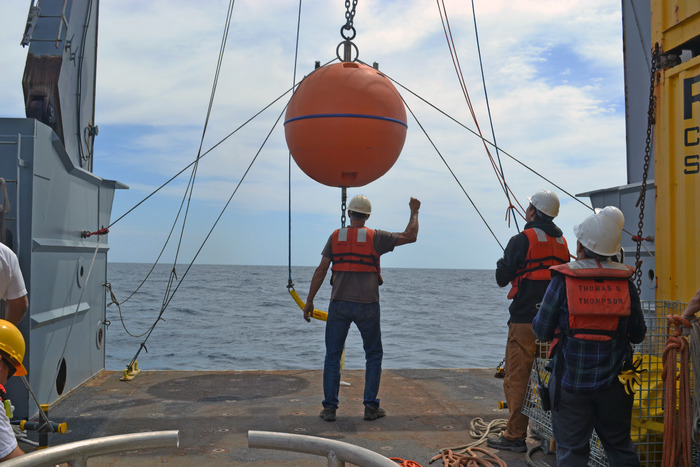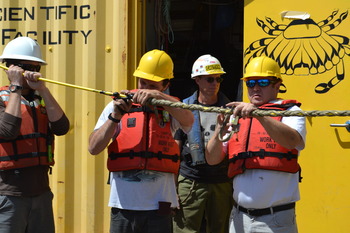Yesterday and today, the team from the University of Washington Applied Physics Lab (APL) has been working long hours on Deep Profiler Moorings that feature an instrumented wire crawler connected to the Internet. These crawlers are designed to probe the deepest depths beneath the ocean surface where deployed. While traversing over 9000 vertical feet of the water column above the seabed, they measure various chemical and biological parameters, as well as ocean currents. These explorers of the deep waters are partnered with the co-located Shallow Profiler moorings that have instrument pods that will travel the shallower waters from ~ 600 ft to just beneath the ocean’s surface. In concert, they will provide both scientists and the general public unprecedented and timely views of the oceanographic processes offshore the Pacific Northwest coast.
The deployment of the Deep Profiler moorings is a complicated process that requires significant amount of forethought and preparation even before the equipment is loaded on the ship. During the mooring deployment, multiple tag lines, cables, winches, and an A-frame are needed to efficiently and safely transfer the mooring components from the ship’s deck to the water.
Deck activities begin near dawn (5:30 A.M. PDT) and APL Principal Engineer Eric Boget masterfully handles the choreography of the APL team and ship’s crew. The first component over the side is the mooring anchor consisting of more than 2 tons of railroad wheels and chains, followed by an acoustic release package for future recovery and a docking station for communications and charging the crawler’s batteries. The 18,000 lb Medium Lift Winch (brought onboard during the previous port call) is used to slowly pay out the 9000 feet and 3200 lb of copper-core mooring line along which the crawler traverses the deep sea. Near the end of the mooring line deployment, the crawler vehicle is connected to a laptop computer for final instructions and carefully coupled to the line.
A full 9.5 hours after the entire process began, the 5 ft diameter orange float that provides the buoyancy to keep the mooring line taught is gently released into the water and the mooring anchor allowed to settle on the seabed. With the mooring deployment task completed, the tired but content team waits for ROPOS to complete the final connection of the mooring to the Cabled Array. The final reward comes shortly later when the shore team at the University of Washington, over 250 miles away, confirms the first receipt of data from the crawler via the cable network.




